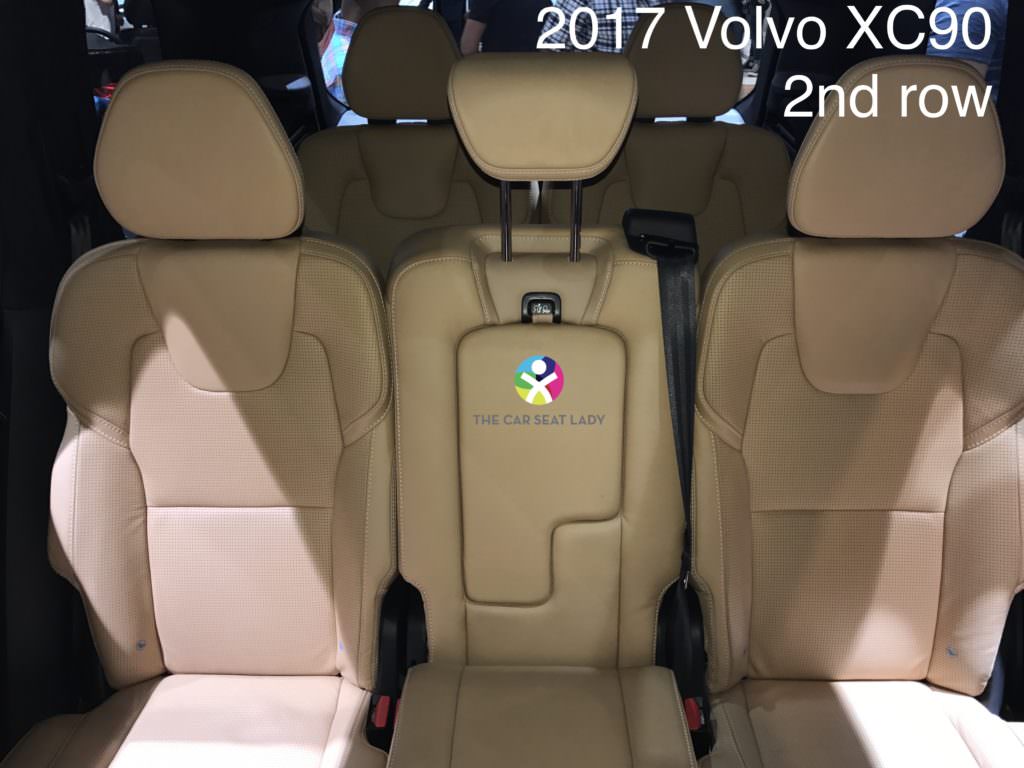Many minivans and three-row SUVs offer a choice of seating in the second row: two seats on either side of the car (often called captain’s chairs) or three seats across (often called a bench, even though it’s never a true bench*). While many family-oriented car buying guides tell you that captain’s chairs are the best choice, particularly for those who need third row access, we feel very strongly that a bench is always better than captain’s chairs, especially for families with young kids.
Did you know there are different kinds of bench seats? Three-seat options in the second row come in two varieties, a 60/40 split, and a 40/20/40 split.
The most common is the 60/40 split, where two of the three seats (usually the driver and center seat) occupy about 60% of the second row and are separate from the third seat, the 40% seat (usually the passenger side.) Usually the 40% seat provides third row access. You can see this type of seating in the Honda Pilot pictured below.

Less common, and shown in the Volvo XC90 photo below, is a second row set up of three separate seats, often called a 40/20/40 split. This means there’s three separate seats in the second row, with the side seats being slightly wider than the center. This set up is often more friendly towards car seat installation. Below the photo you’ll find a chart with a list of vehicles with this seating arrangement.

Minivan:
Chrysler Pacifica (2017 & newer)
Honda Odyssey (2011 & newer)
Kia Sedona (2015 & newer)
SUV:
Audi Q7 (2017 & newer)
Ford Expedition (2007 & newer)
Ford Explorer (2020 & newer)
Lincoln Aviator (2020 & newer)
Lincoln Navigator (2007 & newer)
Volvo XC90 (2003 & newer)
Every parent is tempted to do unsafe things to reach kids in back. Turning around in the front seat puts your life at risk, because your seat belt and airbag can’t keep you safe if you aren’t sitting straight. And kids watch and learn from you. If you’re turning around and leaning over it’s hard to convince your kid in a booster not to do the same thing.
You might also want to sit in the back with your kids, particularly on longer drives when you need to keep them entertained. With a bench in the second row, you can often fit beside or between two kids. However, with two kids in captain’s chairs, an adult can’t reach them safely from any spot in the car. If you sit in the third row you won’t be able to reach the kids in the second row, unless you unbuckle your seat belt. And that obviously puts you (and your kids!) at great risk. Don’t even think about sitting on the floor between the captain’s chairs (oh yes, we know that parents do that). If you do, a crash can turn you into a human missile that triples everyone in the car’s chances of dying.
So, all of this is to say: choose a bench. Benches reduce the unsafe behaviors that parents attempt to access their kids sitting in captain’s chairs.
Understandably, many families fold their third row down to have more cargo space. With captain’s chairs, though, that leaves a large gap for cargo to fly forward toward kids and adults in a crash. In this scenario there is no barrier that will safely divide cargo and passengers: even pressure-mounted dog screens have been shown to dislodge easily in cars and turn into projectiles. A bench seat closes the gap and reduces the probability of cargo flying forward.
Anytime you have to drive a fifth person in a car with captain’s chairs, they’ll have to sit in the third row. That means you can’t keep the third row down to add significant storage space to your vehicle. We know what you might think next: I’ll just fold down part of the third row if one person is sitting there! Not a good idea. When anyone, child or adult, sits in the third row, it’s by far safest to keep the entire third row up. Because everything becomes significantly heavier in a crash (due to G-forces), the passenger in the third row is at great risk of being hit and killed by anything in the trunk. Even a 20-pound stroller can transform to weigh 500 pounds in a crash thanks to G-forces – not something you want hitting your passenger. Keep the entire third row up as a barrier, and put your fifth passenger on the bench.
If you have two kids in rear-facing convertible seats (and you don’t have one of the few vehicles with a car seat safe tipping feature for third row access), it’s going to be very difficult to access the third row with those seats in the way. This dilemma too often leads parents to turn toddlers around to face forward sooner than they should, just to get easier access to the third row. If you had a bench seat, you’d more likely be able to place the two rear-facing seats side by side and either leave enough room for an additional child or adult to sit in the second row, and/or preserve third row access via the empty seat.
Forward-facing kids who get motion sick are most likely to feel best riding in the center of the car where they can see straight out the front window, but if you have captain’s chairs, there is no center seat in the second row. The center of the third row is usually horrible for car sickness, as the third row is much bumpier than the second row. The center of the bench would keep a motion-sick kiddo much happier.
In our experience working with thousands of families on vehicle and car seat safety, we’ve found that the entire family behaves more safely in cars with bench seats rather than captain’s chairs. While easy access to the third row may tempt you, let these many safety concerns convince you to choose a bench instead.
